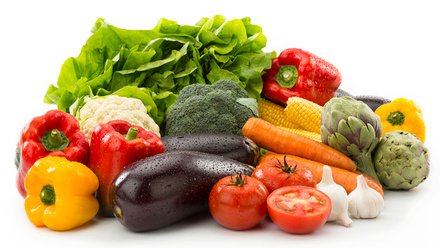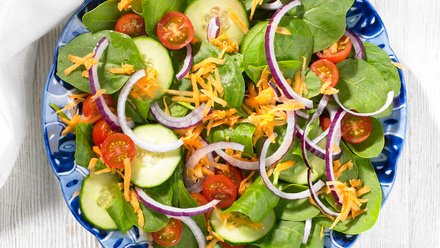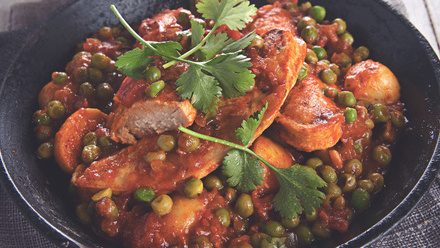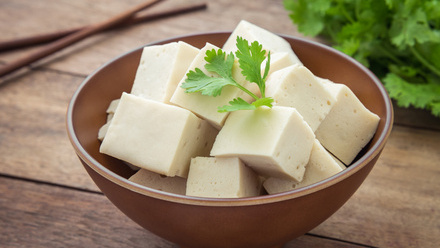It’s easy to be an unhealthy vegan. You could be eating fast foods and processed ready meals, using saturated fat-rich coconut oil in cooking and enjoying vegan chocolate brownies and still be keeping to a vegan diet. But that won’t necessarily be giving you the nutrients you need for good health and energy.
In this feature, Registered Dietitian Azmina Govindji shares simple and practical tips and tricks that can help keep your nutrition on track. After all, it is possible to get all your essential nutrients from plants – it just needs some careful planning!
Picture your Plate – enter VVPC
Try the VVPC plate taken from Vegan Savvy - it has room for all types of plant-based food, and you can use it as the foundation of planning any meal, whether it’s the occasional desk lunch, family dinner, or dining out at your favourite restaurant.
Here’s what you do:
Whenever you eat lunch or dinner, imagine your plate split into four quarters. Fill two of these quarters with vegetables or salad (or a fruit for after your meal), one with healthier carbs (such as brown rice or pasta) and one with plant-based protein (such as a mixed bean chilli). Whenever you sit down to a meal, picture this image, or just think of the letters VVPC to remind you.
You can also download this and pin it to your fridge.
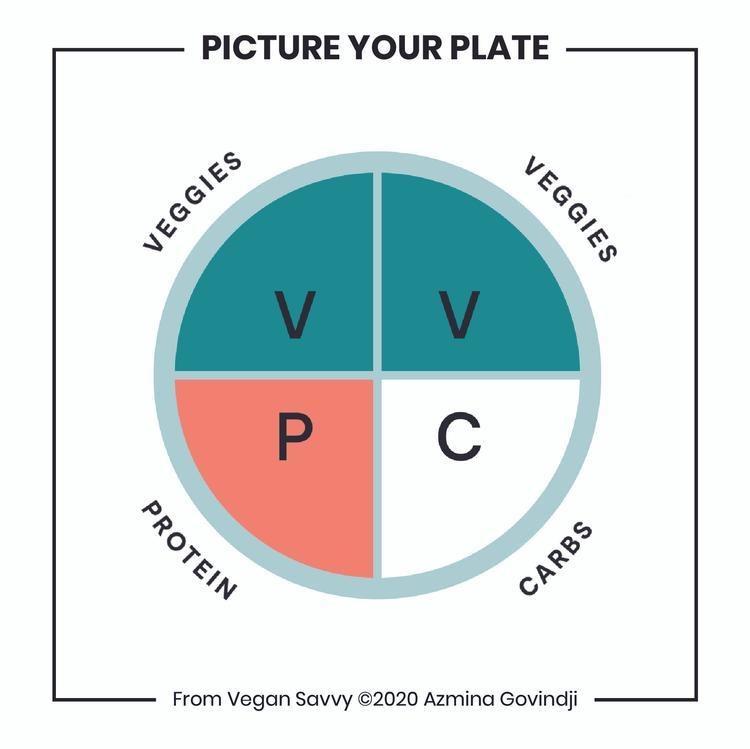
Veggies, carbs and protein sources won’t always fit neatly onto each quarter of your plate, so you may sometimes find it tricky to assess which quarter should have which food on it. It’s not a perfect science, so just try to imagine the different food groups as best you can.
Where the concept came from - the science behind the plate
1. A plate like this forms an integral part of the advice given by the Glycemic Index Foundation, (a not-for-profit health promotion charity supported by The University of Sydney, Australia), primarily for people with diabetes and those watching their weight.
2. The Oregon Health & Science University uses My Heart-Healthy Plate, a similar model intended to help prevent and manage heart disease.
3. The University of Massachusetts Medical School also uses a similar diagram as a portion-controlling method for individuals with diabetes.
4. As recently as mid-2019, the Government of Canada launched a version as their National Canada Food Guide to help the whole population eat better and more sustainably.
5. The Vegetarian Resource Group in Baltimore created a similar image in their My Vegan Plate.
6. In 2004, I introduced the VVPC Picture your Plate as the basis of my best-selling book Gi Plan as a simple way to help you watch your weight and eat well.
Some of the plate models above suggest additional calcium-containing foods outside the plate – I fill the calcium gap with what I call Nutrient Bridges.
The Nutrient Bridge
The Nutrient Bridge is a unique tool originated especially for Vegan Savvy, to help you make simple changes that will enrich your meals.
When you become vegan, it’s natural to start experimenting with plant-based alternatives: you might try unfortified dairy substitutes or vegan convenience foods. But it’s important to consider where the nutrients you might normally get from meat and dairy foods will come from when you’re on a plant-based diet.
Foods from mixed diets provide essential vitamins and minerals that your body needs on a daily basis like calcium, iron, omega-3 fatty acids and iodine, as well as vitamin B12. Some nutrients are less “bio-available” in plant-based foods, meaning they are less able to be used by the body.
Making smart food choices is about eating delicious meals while also being aware of the different factors that affect how your body can make the best use of nutrients from plant-based foods.
A Calcium Bridge
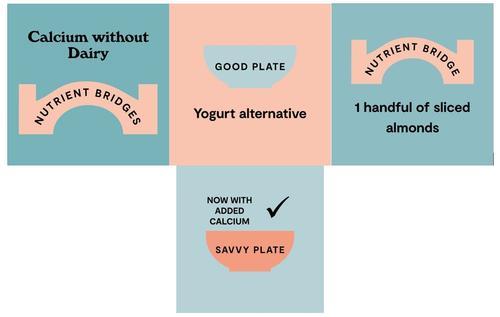
Three Nutrient Bridges to Improve Bio-availability
1. Substances called “phytates” found in wholegrain cereals and legumes can inhibit the absorption of nutrients like iron and zinc. So try having your high fibre breakfast cereal with some berries or 150ml fruit juice (once a day).
2. Spinach and Swiss chard contain substances called “oxalates” that reduce calcium absorption. That doesn’t mean these foods aren’t nutritious; just don’t rely on them for your calcium.
3. Add peppers, tomatoes and green leafy veg to meals. They contain vitamin C and can help you to absorb more iron from vegan foods.
Nutrient Bridges are easy tricks, such as stir-frying carrots instead of eating them raw which helps your body convert beta-carotene into vitamin A. Some bridges are swaps, while others are small additions to your meals, like adding baked beans to your jacket potato for calcium. Some Nutrient Bridges double up as ways to add flavour; a sprinkling of nutritional yeast, for example, is not only a great source of vitamin B12 but also adds a delicious umami taste.
Omega-3 Fatty Acids Bridge
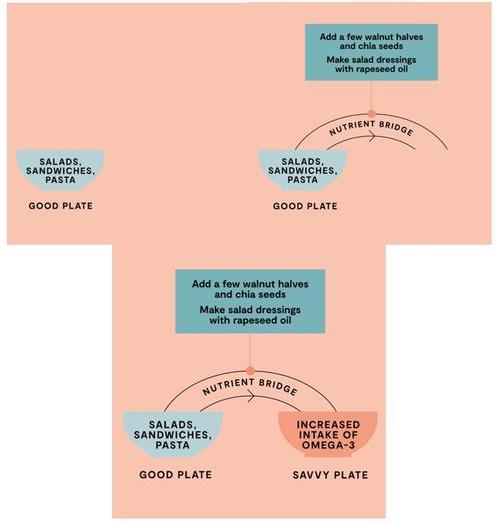
What about Supplements?
Some people prefer to get all their nutrition from real food. Here are six groups of foods you can add to your shopping list if you want to try to avoid supplements. You may still need to take extra iodine, vitamin B12 and omega-3 if you’re not getting enough every day from your diet, but it is easier to meet your needs if you eat the following foods regularly:
1. Citrus fruit, fruit juice (150ml a day), vegetables such as peppers and cabbage, and salad all contain vitamin C, helping you absorb iron.
2. Nutritional yeast or fortified yeast extract spread for vitamin B12.
3. Iodine-fortified foods.
4. Walnuts, hemp drink, seeds, and rapeseed oil (for cooking) help to provide ALA omega-3 fatty acids.
5. Fortified breakfast cereals for iron and B vitamins.
6. Nuts, nut butters and seeds for a range of essential micronutrients.
Take a vitamin D supplement daily, especially in winter months. There’s not enough vitamin D in food.
If you would rather take a supplement to safeguard you against nutritional deficiencies, these are the main supplements you need to consider daily.
1. Vitamin D (10mcg), especially in autumn and winter
2. Vitamin B12 (10mcg)
3. Iodine (140mcg)
4. Omega-3 (250mg vegan DHA and EPA)
5. Selenium (60mcg for women; 75mcg for men)
This doesn’t mean you need to take five pills – it might be easier to find one that gives you everything. Just check the dosages aren’t too high, especially for selenium and iodine.
Five Take-home Tips
1. Choose whole plant foods such as beans, lentils, wholegrains, fruit, vegetables, nuts and seeds in preference to fast foods and processed meals.
2. Follow the VVPC plate for main meals.
3. Add Nutrient Bridges to your meals. They can fill a nutrient gap and help improve the absorption of some micronutrients.
4. Have a portion of calcium at every meal, such as calcium-fortified dairy alternatives, tofu, tempeh, baked beans, soya beans or kale.
5. Take a vitamin D supplement as well as recommended doses of any other nutrients for vegans if you’re struggling to get them from your diet.
Peer-reviewed by Dr Frankie Phillips.
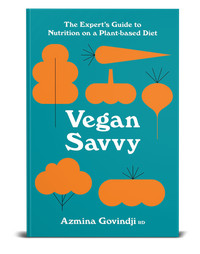
Vegan Savvy: The Expert’s Guide to Nutrition on a Plant-based Diet is supported by the BDA and The Vegan Society. It is available in most good bookstores and online.


